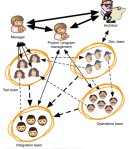
As a technology leader over two decades of experience, I’ve witnessed firsthand the transformative power of A/B testing in driving revenue growth and customer-centric innovation. However, this journey is not without its challenges. In this blog, I share my insights and practical tips to help you and your team master the art of A/B testing without sacrificing quality or speed.
Establish Clear Experimentation Guidelines: Overlooking experimentation guidelines can lead to unforeseen consequences, as I learned the hard way when we mistakenly mixed up test and control cohorts, resulting in inaccurate experiment results and a costly rollout. To prevent such mishaps, invest time in creating clear experimentation guidelines and educating your team on their proper implementation.
Utilize the Staging Environment: Never offload testing responsibilities onto your customers. Always test your experiments in a staging environment before launching them to a subset of users. In one instance, a company failed to test a payment integration in staging, resulting in a $30,000 loss. By adopting a rigorous staging environment testing process, you can identify and address issues before they impact your users.
Implement Feature Flags: Rushing experiments without a proper feature flag framework can lead to chaos. In one project, we had to revert to an older code version after launching an experiment due to the lack of feature flags. Establish a standardized practice for using feature flags to enable smoother experimentation and rollouts.
Enhance User Acceptance Testing (UAT): Relying solely on shift-left testing can introduce bugs into production. To address this, implement Sprint Demos, a practice that allows for early identification and resolution of issues. This agile approach ensures that your features are thoroughly tested before reaching users.
Maintain JIRA Hygiene: A well-structured JIRA framework can streamline experiment tracking and prevent delays. In one company, inconsistent JIRA usage led to a backlog of experiments exceeding their timelines, resulting in revenue loss. Regularly update and track experiments in JIRA to maintain a smooth workflow and identify experiments requiring attention.
Conduct Regular Product Reviews: If you’re running multiple experiments, consider implementing product reviews to collaboratively assess experiment results. This approach not only enhances team learning but also helps identify and eliminate underperforming experiments. Collaborative cleanups are crucial, especially when reviewing legacy solutions.
Implement Continuous Monitoring and Rollback Plans: Even with the best intentions, experiments can go awry. Always have a comprehensive rollback plan in place and continuously monitor experiment progress. Minor anomalies can escalate without proper monitoring. Establishing a regular monitoring cadence ensures swift resolution in case of unexpected challenges.
A/B testing is a delicate balance between innovation and stability. Each challenge we face presents an opportunity to refine our approach. By embracing these insights, you can navigate the world of A/B testing with confidence, delivering impactful features while maintaining velocity. Remember, A/B testing is an ongoing journey of learning and improvement. Embrace the challenges and continuously strive to optimize your experimentation process.
Relevant Hashtags: #ABTestingJourney, #SoftwareDevelopment, #InnovationStories, #TechSolutions, #CodingWisdom, #AgileDevelopment, #ExperimentationSuccess, #ProductReviewFramework, #SoftwareCrafting, #ContinuousMonitoring, #TechLeadership, #UATefficiency, #JIRAHygiene, #DevelopmentChallenges, #RollbackStrategies








